“From 27th of January to 19th of February 2022″
Our first days in Stone Town
It’s been already four months since we are on the road in Africa with our van Uyo. For the second time, we are leaving without it. This time, we leave itr for 2 weeks. The van stays in Dar es Salaam parked in an hotel. We boarded a luxurious and fast ferry. In a way, the opposite of the Ilala we had taken on Lake Malawi (Article 10 Northern Malawi, between lake and mountains).
Once on the island, it’s the return of the French and more generally of the tourists. It’s the first time we meet so many since the beginning of our trip. Tourism is booming in Zanzibar as shown by the hotel complexes popping up on the coast like mushrooms. Nevertheless, most of the island has kept its authenticity.



We spend our first night in Stone Town as lovers. We put our bags down and wander through the narrow streets. The atmosphere is different from the continent. The Muslim religion is dominating with a little oriental touch. The beautiful mosques follow one another. Men wear hats and the women wear pretty veils. The population is welcoming. The architecture is also typically oriental. The balconies of the white buildings are made of small crenels and light openings. Carved wooden ornaments adorn the facades and match the doors. These are large dark wooden doors, structured with metal reinforcements that hold large spikes. They are called anti-elephant doors, although there have never been any on the island. On the main tourist routes, you are lured by vendors who are used to the Mzungus (White people).
The most beautiful shops, wide open on the street, are filled of colourful fabrics, wooden sculptures or paintings. The walls are covered of it from floor to ceiling. A little further on, we find our happiness in the big market. Seasonal fruits and vegetables are sold alongside the island’s famous spices. It is a real olfactory journey, disturbed a little further by the stalls of meat and fish which smell strong with the 33°C of the ambient air.




We also enjoy getting away from the tourist areas. We get lost in the small streets where the shops don’t inflate the prices. It’s nice not to have to negotiate to pay the right price.
Historically, Zanzibar was the seat of the great East African empire that stretched from the top of the Kenyan coast to northern Mozambique. This is where Swahili is coming from. We will keep this language for a few months. It is mainly spoken in Tanzania, Kenya, Uganda and Rwanda.
Paje between friends
While waiting for Valentin’s parents to arrive, we join our friends Delphine and Louis (@horizon toubor), for a week of kite surfing. They brought their van (Toubor) on the island and invite us to sleep with them. Monday morning, we board Toubor and head for Paje in the south-east of the island.
It is a famous spot for kite surfing. The objective of the day is to find a good spot to set up with the van. We walk along the beach to study the terrain. The kite schools and the hotels are all there. In the sky, it’s a broom of kite sails of all colours that cross each other. The last school is at the end of a sandy road. As we get closer, Louis sees a few cars parked just behind. Bingo! We have our spot! At least, we hope so. We still have to manage to drive the van here. Unlike our Uyo, it is not a 4×4.




As a great driver, Louis passes between two coconut trees, with his side mirrors closed. To our great surprise, he easily reaches the kite club car park. The next step is a little more complicated. We want the best place to spend our next nights. The list of criteria is long: sea view, the door on the right side, in the shade all day, flat ground, etc… After a few sand dunes, the list of requirements became lighter. But as the pictures show, we are far from being to be pitied.
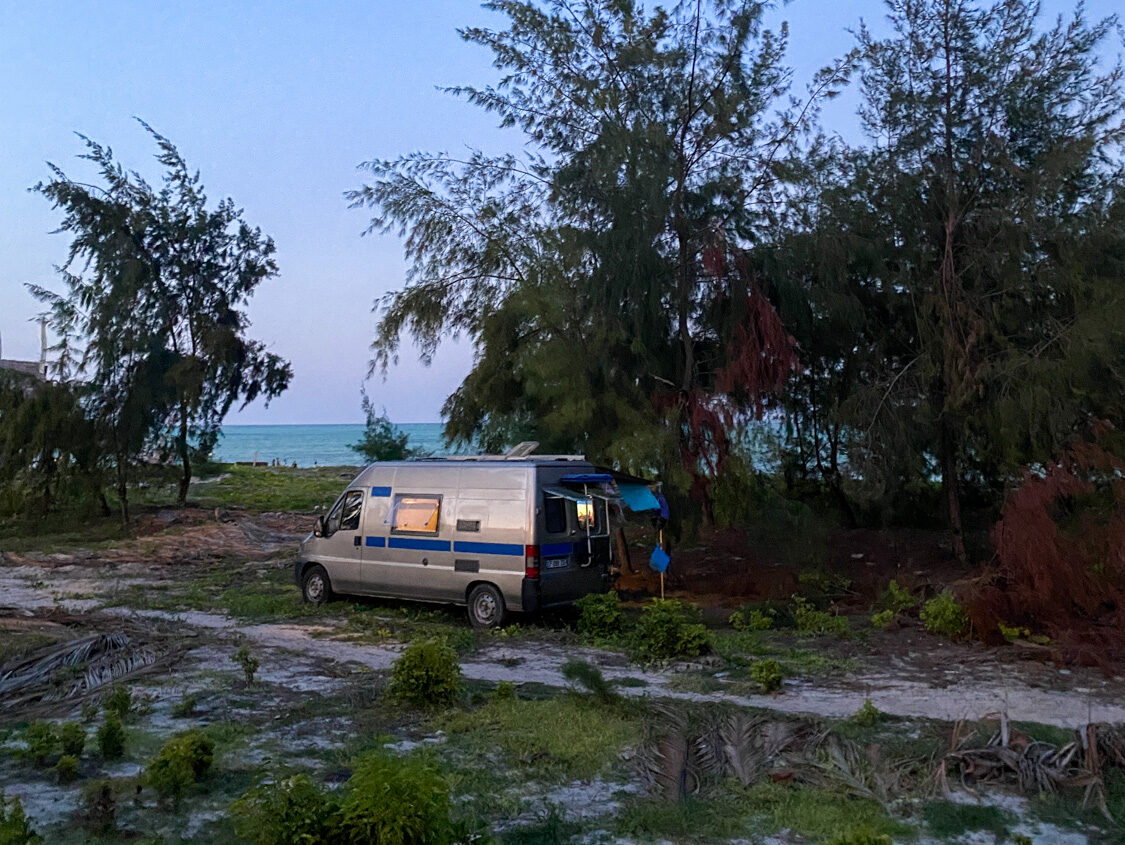


An offshore wind blows all week. Every day we put on the harness and the sail to sail along the coast. We progress rapidly until we become autonomous.
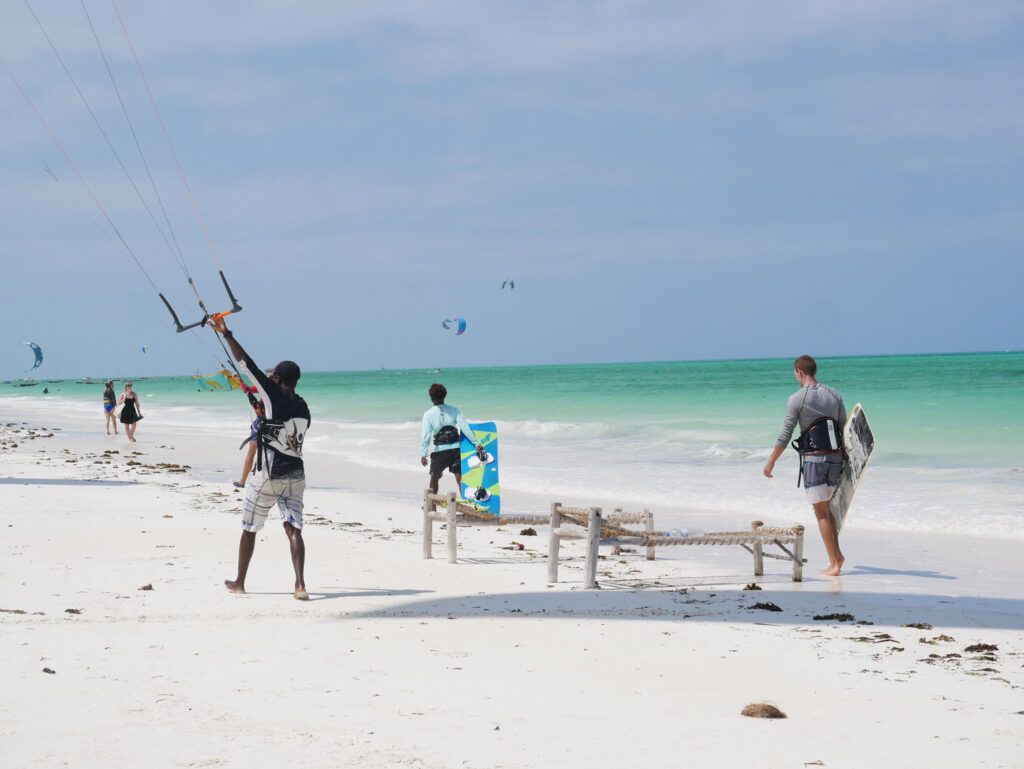




Between two kite surfing sessions, we visit the lodges along the beach in search of the cheapest drinks. We also take the opportunity to test the swimming pool of the most beautiful hotel in Paje. In the evening, we cook the day’s catch on Louis’ little barbecue.





Family reunion
After 5 days with the guys, it’s time to go back to Stone Town to meet Valentin’s parents. We start by discovering the city the first two days before renting a car. Then we have the freedom to go on our own.


Big buddy farm
We start at the spice farm in the countryside. As soon as we get out of the car, the smells spread around us. It is difficult to recognize them because they are so mixed. A guide welcomes us and takes us through the farm. He speaks very good French and even surprises us sometimes with expressions such as: “je parle français comme une vache espagnole”, Meaning: “I speak french like a Spanish cow”
The tour begins with the discovery of a red-orange dye widely used by women for make-up, but also in the kitchen. This is where the red colour comes from, which is found in the masala spice mix. We learn to recognise lemongrass, nutmeg, cinnamon, ginger, turmeric, ylang ylang flower, etc.





Here four kind of peppers are grown, green, red, white and black. All come from the same tree but are harvested at different maturities and are processed with or without skin.


The coffee found on this farm does not taste like Arabica. It is more bitter. It is called Robusta.


The cinnamon, called the king tree by the locals, surprises us. The smell of its bark is well known but do you know the smell of its roots? We discover a strong smell which is very similar to Vix. This part of the tree is used to treat illnesses such as colds. The leaves also have a medicinal use.




The paradisiacal beaches of Zanzibar
No two coasts are alike. Besides the famous blue water and white sand, the landscapes are different. We first discover the south-east and the beach of Kizimkazi . Less touristic than the north, it is not less incredible. The beach offers beautiful colours at low tide. The very fine white sand contrasts with the fluorescent green algae. The ocean continues to recede, pronouncing the blue gradation on the horizon. Seaweeds are cultivated by locals. They are then used as gelatine for cosmetic products in particular, or yoghurts. It is the second economy of the island after tourism. It is here that we choose to make our first snorkelling excursion. When we arrived on the reef, we discovered a magnificent show underwater. Fishes gravitate in number around the rocks covered with marine flowers. We find Nemo and Dori but also all their friends. Although some of them still have some of their colour, most of the corals are white. This is another sad impact of climate change we are witnessing.






The beaches in the north of the island are made of a beautiful pure blue. Away from the water, the village square with the fish market stands. The cows rest in the shade, as do the men who sip their delicious sugar cane juice with ginger and lime. Some play Carrom. Valentin, curious, approaches them and is quickly invited for a game. He comes out a winner and happy with this little duel.

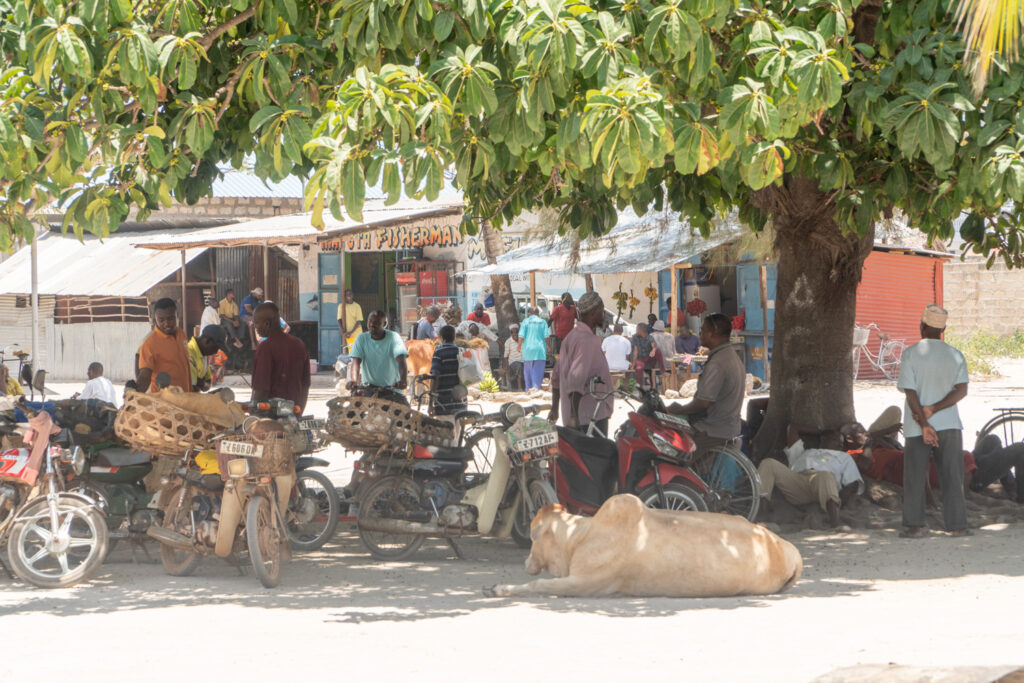



The north of the island is also known for its colourful fishes not far from Mnemba Island. The small private island belongs to Bill Gates. Equipped with our inflatable kayak, our masks and snorkels, we leave for a second underwater expedition. Valentin’s parents rent a boat with a captain to go to the same reef. Paddling takes a bit longer, but we quickly find them underwater. We are not disappointed. Fish of all colours are once again very numerous. The water shows a beautiful turquoise colour in the sun. From the sandbanks of the island a gradation from white to navy blue is formed until the open sea.





Friday morning we leave for Paje, we want to show the parents this beautiful beach. It’s also an opportunity to show them our progress in kite surfing.





On the way we cross the Josiani forest in the south of the island. It is home to many monkeys, notably the Colobus, endemic to Zanzibar. Long red hair surrounds their face and covers their back. Just as curious as us, they do not hesitate to approach us. We are quickly surrounded. We did not expect to see them so close. At this distance, just like us humans, each being is unique. You can easily recognize an individual by his facial features, his expressions and his morphology. All that remains is to give them names.





Our stay in Zanzibar is coming to an end. On the last day we meet Peter. He looks after the house next to our hotel. Open to new encounters, he called out to Valentin through the fence on his terrace to offer him a fresh coconut.



Valentin wonders if he is expecting anything in return. But as the discussion goes on, he soon realises that Peter is just looking for new friends and have a good time. Less than 5 minutes later, Valentin is on the other side of the fence. He also meets Freddy and Peter gives him a tour of the property. It is a beautiful house owned by a rich Arab. He hasn’t been back here for years. Peter takes care of the rental management. He suggests that Laurène and the parents come to his terrace too. Freddy is already on top of the coconut tree to offer them some nuts too. Tonight they want to have a barbecue with us. We go with Peter into town to buy squid and octopus.


At the table we practice Swahili, now everyone knows a little bit of it. We get to know each other better during the meal. The photos on the phone help us to communicate. We leave with a full belly and new memories in our heads.
Mikumi national park
After Zanzibar we plan to take Valentin’s parents on safari. We all return together to Dar es Salaam to meet our Uyo van. It will take us to Mikumi, the nearest national park. It is still a 6 hour drive due to the high truck traffic. This is a road we know well. We used it to reach the Tanzanian coast from Malawi (Article 11 – Our nights in the wilderness on the road to Dar Es Salaam). The journey in the heat is tough, despite a stop on the road in Morogoro.
For the safari, we chose to book a game drive unlike Kruger (Article 5 The Transvaal region of South Africa: Kruger and Blyde River Canyon). That is, a vehicle with a guide to drive through the savannah of the park. Uyo is not suitable for 4 people and in the rainy season we don’t want to risk getting stuck. Another advantage is that the guides communicate with each other to find the rarest animals, especially the big cats.



This is the first safari for Valentin’s parents. We quickly find the first animals: impalas, giraffes, elephants and warthogs. The rainy season has recently started in this region and the grass is now very high in the savannah. It is not always easy to spot the animals. Nevertheless, luck is with us. Our guide receives a phone call from a colleague in the morning. Lions are lying near the road.





After lunch, we set off again on the small roads of the park. Several stopped cars indicate that a leopard has just climbed the tree we see in the distance. After an hour of searching, our patience is finally rewarded. The panther finally decides to come down from its perch. She walks with dexterity along the trunk. We continue our journey and the encounters with wild animals follow one another. At the end of the day, the rain surprises us. We decide to return. On the way back, we have the chance to observe a new animal, the jackal, followed by a majestic leopard which chooses to cross the road in front of us. It then slowly moves away into the savannah. Its body gradually disappears under the tall grass.


We were very lucky with our guide. Silas is not only passionate about nature, he is also an excellent driver. We learned a lot from him:
- A male giraffe can be recognised from a distance by its third horn in the middle of the forehead. In addition, unlike the female, he has no hair on his horns.

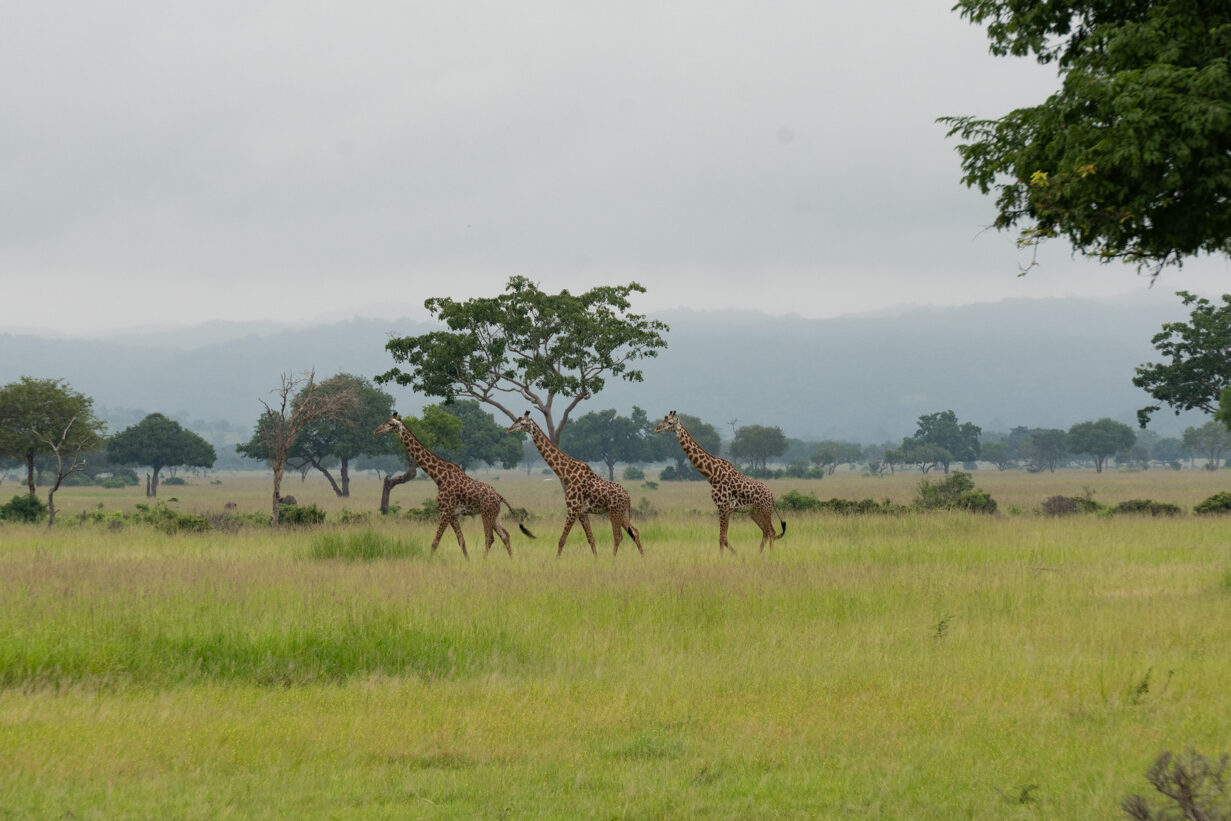

- elephants yawn to cool their brains located at the very top of their heads.
- Their teeth are renewed 6 times. Once the last generation of teeth has fallen out, elephants have difficulty feeding and eventually become weak. Could a new set of teeth extend the life of an elephant?


- The main colour of the zebra is black. They can be recognized by their snout, which remains black throughout their life.
- Each zebra has unique stripes like our fingerprints. Their black and white colours help them to avoid attracting too much sunlight. They also protect them from predators, who are confused by the stripes when the zebras start running.





- Impalas generally live in groups: either in harems, one male for many females, or between bachelors, males only. Some are alone, these are the males who have lost their harem following a fight with another suitor.




All good times must come to an end. It is time for Valentin’s parents to go home. They are relieved by Rodolphe who lands with the plane they are taking to go back to Europe.


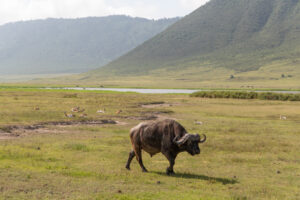
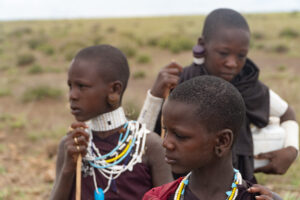

Pingback: Uyo's Passengers #14 Ngorongoro a new Wonder of the world